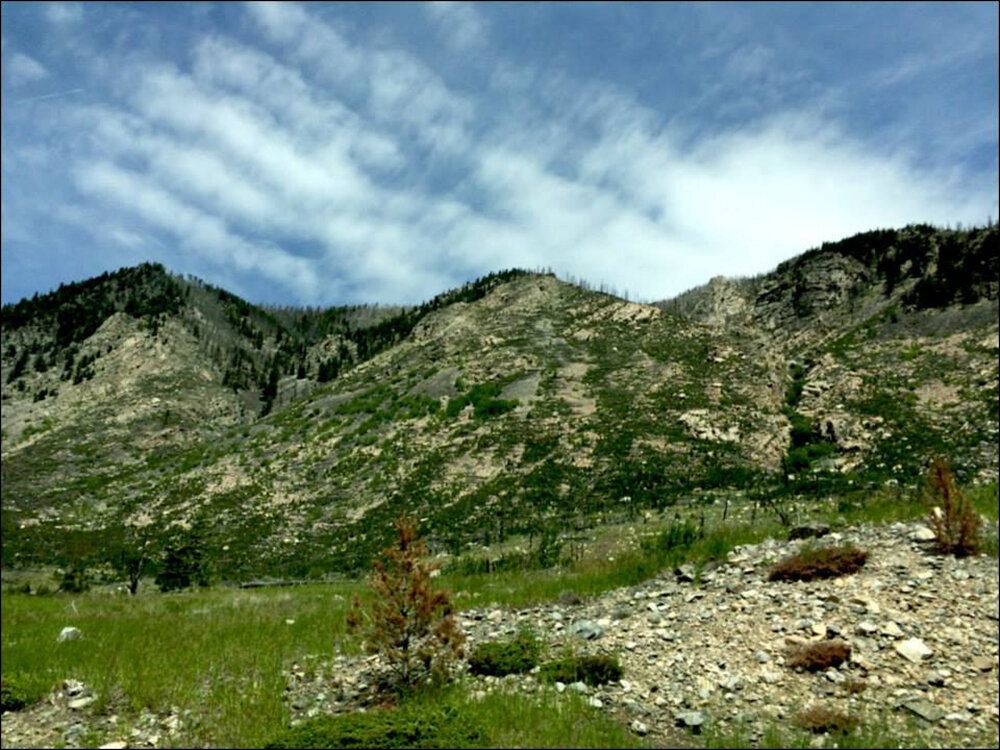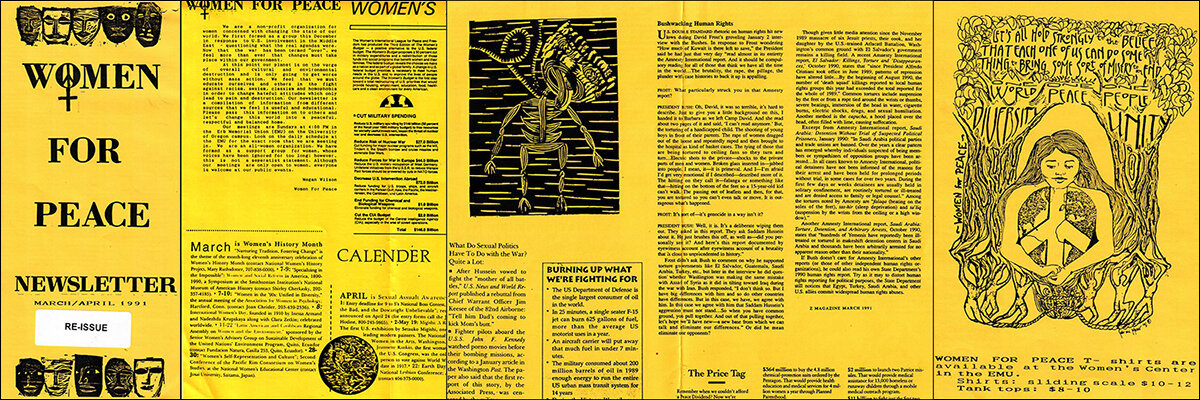Beginnings ... On becoming a political artist and organizer
Megan Wilson, Self-Portrait, woodcut, 1991
I grew up in Billings Montana, the largest city in the state with a population of 100,000. It’s an isolated place to live with the next largest city being Denver, eight hours away - not taking into account that everything is now so readily available via the internet, which didn’t exist when I was a child and teenager. The general feeling of Billings as I was growing up was much like that of a suburb with a relatively small downtown area, few buildings over 5 stories, several four-lane main streets, one museum/art center, five high schools, sporadic strip malls, and a larger one-level mall with a multiplex theater that was built in the seventies. However, rather than lying on the outskirts of a large city, Billings is bordered by the Crow Indian reservation and surrounded by a breathtaking natural environment with plains to the east and north, and the Rocky Mountains to the south and west. The city is also lined across the north side with rim rocks that house a myriad of caves and wildlife. The culture of Billings is a mix of the painful and violent history of “manifest destiny” that annihilated much of the indigenous peoples and wildlife of the West and gave justification to the white elitism that now primarily runs the state. This culture of American exceptionalism is accompanied by cowboy culture, the struggles of American Indian tribes to maintain their cultures and dignity amidst the brutality of the west’s white supremacist history - 7% of Montanans are Native American, outdoor adventure, and a desire to emulate a modern metropolitan lifestyle. Drinking is probably the number one pastime throughout the state - Montana ranked #5 amongst states for the most alcohol consumed (study by HealthyPeople.gov). Montana also ranks #2 for death by suicide. (Center for Disease Control).
Border between Billings and Crow Reservation, Montana
My experiences growing up in Billings mirrored this characterization in a number of ways: 1) My father’s family has been in Montana since the late-1800’s, and includes my Jewish ancestors who moved to the state in the early 1900’s. The Western/cowboy heritage was always a part of our lives – going to rodeos, Western attire, and listening to country music; 2) my closest friends and boyfriends from elementary school through high school belonged to the Crow, Sioux, and Oneida tribes (their families often took me in for weeks at a time when I was having problems at home); 3) my parents were great outdoor enthusiasts and every weekend we/they were either hiking, biking, cross country skiing, fishing, or rafting; 4) my mother was obsessed with the design and decoration of our home; 5) I was a full-blown alcoholic by the age of 14; and 6) I was forced to move out on my own when I was 16 after being assaulted by mother’s married, alcoholic boyfriend, which followed on two suicide attempts (my parents divorced when I was 12 and my father and his new family moved to Red Lodge, an hour from Billings). I moved into an unfinished concrete basement of a house that had little light and also acted as the laundry room for the owner of the house. My living space was an area of approximately 7’ x 10’; I had an area rug, a bed, and a dresser. To support myself, I worked at Burger King 30 hours/week, while also attending high school.
Childhood
This all took place within the affluent white community of doctors, lawyers, and businessmen in Billings. My father was an attorney at the law firm of Crowley Haughey Hanson Toole & Dietrich - as was the married man who brutally assaulted me.
I note this because it was my introduction to the disparities of race and class, as well as misogyny and domestic violence.
It was painful and embarrassing to me that while my parents/family and their friends’ families all had large homes (relative to that era), fancy cars, cabins in the mountains, and plenty of money etc; my friends’ families did not. Yet their parents worked just as hard, often much harder - holding down two or three jobs, as well as my friends having to work and contribute their incomes to their households. The only difference was that most of my friends were brown and/or their parents were working class laborers, service providers, or clerical support.
As a kid without agency, who had never had close friends from money because I had been ostracized by them, being told I was ugly, I loathed those kids and avoided them as much as I could. My best friends and later boyfriends were from working class families, which is where I felt the most at home. Except when I found myself lying on the bed of my first boyfriend, who is Oneida in the room he shared with four of his brothers. He told me that I was different because of where I came from. We were in 10th grade and he had to work at restaurant as a dishwasher to help support his family, I did not; however, a year and a half later I would, out of necessity to support myself. And when I found myself taken in by my two best friends, also American Indian (Crow/Apsáalooke), sisters who lived with their single mother in a small apartment. One day we were making tuna fish sandwiches for lunch and I went to make a second one. The elder sister had to tell me that we could just have one because we needed to ration the bread and tuna for the next day. I felt so ashamed and ignorant because our family always had way more food than we ever needed. Both of these experiences were crushing to me. I felt so alone … even though I wasn’t and my friends loved and cared for me; I was different. My family had money and social status, yet they had abandoned me - I was different from them as well, and really didn’t fit in anywhere.
High school
These early experiences are what shaped me and how I understood the world, its inequities and the cruelties of capitalism as a system rooted in racism, misogyny, ecocide, and white male dominance. I wouldn’t fully understand those structural and systemic connections until far into my twenties; however, at an experiential level, I knew it, and lived it, either directly or as an observer.
By the grace of some larger force, and lots of support from my friends, I did get into college at Montana State University, where my dad had done his undergraduate work. However, I knew that I needed to get out of Montana. I applied to the University of Oregon through the National Student Exchange program and thankfully was accepted. It allowed me to transfer and pay the same in-state tuition as MSU. It was game changer. My life opened up to so many new possibilities and perspectives. There were people who lived off the grid. They lived on communes and in old transformed school buses and other vehicles. They were creating their own realities. Realities I never knew existed. Realities outside of mainstream culture. Additionally, while I had spent the first three years of college as a business and communications major, I realized during that third year I loved art, I could write, I could be political, I could help others, I could be an organizer. I could be myself.
Megan Wilson, The Cycle of Humanity, woodblock print, 1991
Megan Wilson, War Is Peace, woodblock print, 1991
Megan Wilson, The Bottom, woodblock print, 1991
Megan Wilson, The Hundredth Monkey, woodblock print, 1991
Megan Wilson, Thou Shalt Honor Thy Father, monoprint, 1992
In 1991 I officially changed my major to fine art with an emphasis on printmaking. I loved the highly graphic nature of the medium and the ability to create multiples. I also loved that it was a medium that allowed me to express my social/political views and experiences in the format of the artist book.
Women For Peace newsletter, March/April 1991
1991 was also the year of the Gulf War’s Operation Dessert Storm, during which the United States began a massive bombing campaign against Iraq that resulted in the deaths of 100,000 - 200,000 civilians. In response, I worked with a multigenerational group of women, who were a mix of University of Oregon students and non-student activists to form the organization Women For Peace. WFP held weekly support groups for women and organized public events (film screenings, talks, forums, concerts etc). I was in charge of creating the bi-monthly newsletter, which was primarily a compilation of news articles from various sources (Ms. Magazine, Z Magazine, The Nation, Mother Jones, among others); I would also include images from my political print works.
These are my beginnings as a child and youth in Montana and how those experiences led to my early days as a young artist and activist in Oregon and then beyond.









